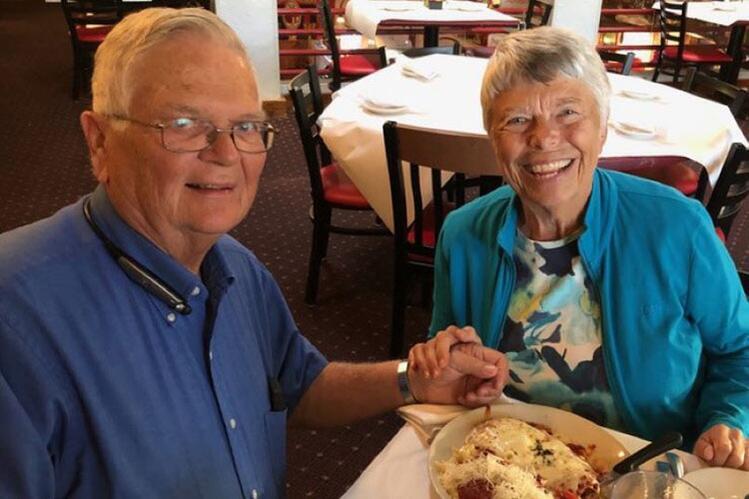Alumnus John Tunnell helps ABE students “get a good start”

John Tunnell’s journey to an advanced degree in agricultural engineering was longer than most, but it gave him the experience and insight he needed to succeed in a career that was off the beaten track.
John studied agricultural science at Southern Illinois University for two years before transferring to Illinois in September of 1963. “I had no family farm to inherit, so I needed to expand my education,” John says. “When I came to U of I, I originally asked to enroll in agricultural mechanization, which I thought would give me a broader education but still be connected to the agriculture field. My advisor suggested I enroll in agricultural engineering, so that’s what I did. And since I already had two years of study in ag science, I decided to go for a degree in that area as well.”
The ag engineering/ag science track added a year to his time of study. John also enrolled in a training system with Caterpillar which allowed him to alternate semesters at Caterpillar with semesters at Illinois. John married his college sweetheart, Marge, in September of 1966.
They completed John’s final year together and he graduated in the spring of 1967, with degrees in Ag Engineering and Ag Science. Marge spent one more semester at Illinois and graduated in January of 1968 with a degree in Education (teaching Biology).
As a student, John went through Air Force ROTC, so he and Marge spent the next four years at Vandenberg Air Force Base in California, where John served as a civil engineer.
“After leaving the service, I thought it would be a good idea to come back to Illinois to get a master’s degree to reacquaint myself with ag engineering,” he says. “I specialized in the mechanical side of the agricultural engineering field, and I enjoyed the more ‘applied’ education I received. I took courses in the College of Engineering, and was successful, but when I took the more applied approach in the ag engineering department, I would often say to myself, ‘Oh, that’s what they meant in that engineering class.’”
After receiving his master’s, John’s professional career began at Food Machinery Corporation in Hoopeston, Illinois, while Marge taught biology at Danville High School. “I was asked to design a machine for the mushroom canning industry, to cut the caps from the stems of mushrooms being commercially grown,” says John. “I created a successful machine, but a competitor beat us into manufacturing the machine.”
Two years later, a relative asked John to go to southern Virginia to help build and operate a plant to grind peanut shells and ship them back to Illinois, where they were mixed with molasses to create cattle food. “I operated that plant for two years, then Marge and I decided to return to the Danville area. Marge returned to teaching at Danville High School, but I needed a job.
“I interviewed with a company named Teepak,” he says. “They manufactured wiener skins, and I wasn’t sure why you needed an engineer to make wiener skins. I didn’t realize how much engineering support was needed to keep a manufacturing plant operating. After the interview, I was asked to come to work the next day.”
In 1979, the company sent him to a new plant in South Carolina. “I had done some engineering on their manufacturing equipment. Eventually, I became part of the plant management staff, where I managed about a third of the operation. In that plant we created edible skins that you find on breakfast sausage or beef sticks.”
Ten years later, John says, “Teepak’s sales and marketing department talked me into moving to the Chicago area. My title was marketing manager, but I was essentially technical support for our sales staff. I worked with them and our customers to solve problems with our product or their equipment. When a customer wanted a new product that we didn’t manufacture, I worked with the customer and our manufacturing plant to create the new product. That, of course, created new sales for our company.”
John believes his career could be a lesson in flexibility for students today. “When I was at Illinois, I just assumed I would work for John Deere, International Harvester, or Caterpillar. But there are a lot of other opportunities out there, as you can see from my job path. I realized early on that engineering design was not my strong suite. Engineering support was, and it gave me a very successful career.”
John and Marge have donated to the University of Illinois Foundation for many years. Recently they made the decision to donate to the Engineering Visionary Scholarship Initiative in The Grainger College of Engineering, with the funds directed toward the Department of Agricultural and Biological Engineering. John says, “We feel that given the success we’ve seen in life, we want to help others get the good start that we got at the University of Illinois.”
John retired in 2005, and he is “enjoying retirement immensely.” The Tunnells spend summers at their country home near Oswego, Illinois and winters in Naples, Florida.